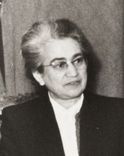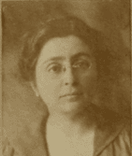Education: A Key to Elevating Women in the World of Work?
Education has been a crucial yet often overlooked aspect of women’s labour activism. Limited access to education and gendered ideas about education continue to be a key component of gender inequalities. Throughout the twentieth century, the educational discrimination women faced contributed to wage inequality and occupational segregation. The lack of access to education also reinforced women’s marginalization in the organized labour and women’s movements.
Indeed, education is doubly important for activism. On the one hand, ensuring access to education has been at the heart of the efforts of many activists. On the other, for many working women, receiving an education served as a catalyst for their own activism. For activists like Szeréna Ladányi from Hungary, education was an unquestionable means of women’s emancipation. Committed to offering women opportunities to become economically independent and politically aware, she stressed that “the ignorant person is always exploited by others”.
Multiple barriers prevented women’s full participation in education and vocational training. Formal exclusion, entrenched social prejudices, and the resistance of male workers have all limited women’s opportunities for skill development. In turn, the actual skills of women workers often did not receive formal acknowledgement. Women’s position in the household – often bearing a double or even triple burden of work, childcare, and domestic responsibilities – restricted their access to education. Many lacked the time, financial resources, or family support necessary to engage in training, reinforcing cycles of economic vulnerability.
Improving women’s access to education (1900s–1930s)
At the start of the twentieth century, women faced severe limitations in their access to education, including vocational training, across Central, Eastern, and Southern Europe and globally. The lack of educational opportunities for women in rural areas was a particularly long-standing problem. Yet even in urban areas, women’s access to schooling remained limited and unequal.
If women could enrol in vocational training, they frequently ended up with curricula that were only truncated versions of men’s courses that effectively locked them into underpaid auxiliary jobs. Such a situation was not limited to industrial labour. In Hungary before World War I, women who wanted to become office clerks, unlike men, could not pursue the three-year-long training in a secondary trade school. Instead, they had to opt for practice-oriented courses that lasted up to ten months and only prepared them for lower-level work. Working women and activists alike gradually came to see this situation as unsustainable.

A class of young dressmakers in an Ankara college, Turkey, 1930 (Source: Topfoto)
The importance of activists’ education
In the 1920s and 1930s, trade unions increasingly organized courses that targeted workers. These were not limited to political education and the training of representatives; they also included wider cultural educational programs for rank-and-file members, and some explicitly addressed women workers’ needs, including offering women-only classes. Left-wing parties also engaged in educational programs, recognizing that politically educated women were crucial for labour movements. In the first half of the 1930s, for example, Szeréna Ladányi was one of the main advocates for political education for women within the Social Democratic Party of Hungary. An experienced teacher, she wrote the party’s women’s education program and organized a seminar specifically aimed at women from rural areas.
Women’s participation in worker-led training, however, generally remained low due to time constraints and domestic responsibilities. Societal attitudes, too, remained a challenge. Many women struggled to balance education with their household duties, and their participation in political and labour activism was often met with resistance from male colleagues and family members.
Post-World War II developments
After World War II, the devastation of the war drastically altered economies and labour markets, creating the need for more workers, including women, to support industrialization and economic reconstruction. Women’s vocational training also increasingly became a priority for both national governments and international organizations. The increased interaction between national governments, trade unions, and international organizations meant that women’s education was no longer just a domestic issue but a global concern, influencing labour policies and gender equality initiatives on an unprecedented scale in the post-1945 period. At the same time, the emerging Cold War divided the world into competing ideological blocs, with both capitalist and socialist states seeking to integrate women into the workforce as part of their broader economic and political strategies.

Group picture of graduates of the Derecske Agricultural College in 1948 (Source: Hungarian Agricultural Museum and Library, EF_5316)
International organizations such as the International Labour Organization (ILO) and United Nations Educational, Scientific and Cultural Organization (UNESCO) played a crucial role in promoting policies that encouraged women’s education and vocational training. The ILO, which had been founded in 1919 to improve labour conditions worldwide, increasingly focused on gender equality in employment and education in the postwar years, advocating for equal access to vocational training and the elimination of workplace discrimination. UNESCO, established in 1945, emphasized education as a fundamental human right and worked to expand access to schooling, particularly in regions where women’s literacy rates were low. These organizations provided a platform for knowledge-sharing and policy coordination, helping women labour activists advocate for reforms in their own countries by drawing on international labour standards and human rights frameworks. From the 1950s onward, international trade unions like the International Confederation of Free Trade Unions (ICFTU) and the World Federation of Trade Unions (WFTU) organized educational programs for women. These efforts sought to integrate women into trade union leadership and improve their representation in decision-making roles.
But reaching women living in the countryside remained a challenge for activists across the region. The efforts of different institutions and associations converged when it came to offering education to rural women. In Yugoslavia, for example, it was co-operatives and women’s organizations that pursued this goal. Activists of the Co-operative Women’s Sections educated women in agricultural production, emphasized their position as workers, and advocated for the socialization of household work. They also sought to promote more women into decision-making positions within co-operatives. Some activists even moved from urban to rural areas to provide education to peasant women on the spot. In the early 1950s, Rajka Borojević (1913–73), a teacher from Herzegovina and former Central Committee member of the Women’s Antifascist Front of Yugoslavia, settled in a village and started organizing workshops for peasant women.
New advances, new challenges
The 1970s saw increased international attention on women’s rights, culminating in the UN’s declaration of International Women’s Year (1975) and the Decade for Women (1976–1985). These initiatives led to research on women’s education and employment, revealing that gender segregation in the workforce remained a major issue. In both state socialist and capitalist countries, women were overrepresented in lower-paying, lower-skill jobs. Even when they attained higher education, their career progression was hindered by entrenched biases and social prejudices.
The Committee of Bulgarian Women, for example, reported in 1971 that many women worked in industries that were classified as “light” because they overwhelmingly employed women – clearly a misnomer, the Committee stressed, because the labour in such industries was often actually arduous and unsafe. The Committee also denounced managers and foremen who deliberately refused to promote women.
Importantly, such research and critical reports stemming from the Committee started new conversations about the role of women as labourers, as well as exposed the hurdles and arbitrary limitations many women employed in waged work faced, such as the discriminatory attitudes of male colleagues, managers, and family members.
The 1980s witnessed stronger collaboration between women trade unionists from both sides of the Cold War divide. Educational exchanges between trade unions in Hungary and Austria, for example, allowed activists to share strategies for improving women’s access to education and leadership roles.
Even though many activists, organizations and governments across the region took up the cause of women’s education, many challenges persisted. For working women who typically shouldered the bulk of the household and care work, continuing their education was often difficult if not impossible. This meant that high dropout rates remained a problem for many educational programs.
By the late 1980s and early 1990s, the collapse of state socialism introduced new challenges for women in the workforce. As market economies replaced socialist policies, women faced job insecurity and declining social protections. International trade unions, particularly the ICFTU, sought to address these issues by organizing educational programs for women in post-socialist countries like Poland, Hungary, and Romania.




